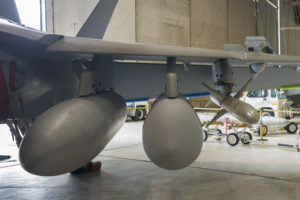The Pentagon’s top weapons tester said the Navy’s Next Generation Jammer Mid-Band (NGJ-MB) faces significant operational effectiveness and suitability challenges as it proceeds into the initial operational test and evaluation (IOT&E) period.
“The Navy needs to overcome several challenges to demonstrate the NGJ-MB’s operational effectiveness and suitability as it proceeds to IOT&E. The lack of validated or accredited digital models needed to supplement NGJ-MB operational flight testing present a significant risk to NGJ‑MB IOT&E,” the FY ‘21 annual report from the Director, Operational Test and Evaluation (DOT&E) said.
This year’s report, which was released on Jan. 27, summarizes the developmental testing status of the Defense Department’s highest profile weapons systems.
The NGJ program is replacing the legacy ALQ-99 tactical jammer used by EA-18G Growlers against enemy air defense and communications systems. It is made of two pods mounted under the aircraft’s wings and is divided into low-, mid- and high-band frequency contract increments, with NGJ-MB as Increment 1.
Last year, Acting Assistant Secretary of the Navy for Research, Development and Acquisition Jay Stefany approved the NGJ-MB for Milestone C, allowing it to move to Low-Rate Initial Production (LRIP) (Defense Daily, June 30).

The Navy then awarded Raytheon Technologies [RTX] the first LRIP Lot One contract last July for the first three NGJ-MB ship sets with those initial orders expected to be delivered by October 2023 (Defense Daily, July 6, 2021).
The DOT&E report noted Milestone C was approved without the program completing a planned capabilities-based test and evaluation period and there has also been no operational testing conducted on the NGJ-MB thus far.
To pass Milestone C, the Navy used a combination of ground-based testing and early developmental flight testing to assess NGJ-MB performance against system specifications. Since the Navy did not accomplish the planned early operational tests, the service moved them to a Capabilities Based Test and Evaluation period just before IOT&E.
However, DOT&E warned that “if the tests are not accomplished prior to IOT&E, then they will occur during IOT&E and likely extend the planned IOT&E schedule.”
The report said that “the Navy needs to overcome several challenges to demonstrate the NGJ-MB’s operational effectiveness as it proceeds to IOT&E.”
While the system has achieved some key performance parameters, it is “still underperforming in several important areas.”
Notably, DOT&E argued that “the lack of validated or accredited digital models needed to supplement NGJ-MB operational flight testing present a significant risk to NGJ-MB IOT&E.”
NGJ-MB lacks validated or accredited digital models needed to supplement operational flight testing, which presents a “significant risk” to the system’s IOT&E. While the Navy has a plan for validation, it has not been able to collect the data necessary to validate its models.
The report said the operational test team determined operational test flights have to start in the third quarter of fiscal year 2022 to collect the necessary data for model validation and also have time to complete all planned operational test events by the planned end of IOT&E.
The report warned the System Demonstration Test Asset ship set pods will probably be delivered to the operational test team later than the third quarter of FY ‘22, “which may not allow sufficient time to validate, accredit, and use the digital models to supplement the flight test data. In addition, test data classification problems have prevented M&S personnel from analyzing the data.”
DOT&E said the Navy also needs to overcome “several challenges” to demonstrate the NGJ-MB’s operational suitability as it moves into IOT&E.
However, the report did not disclose its full preliminary analysis, which is disclosed in the Controlled Unclassified Information (CUI) edition of the report. For the first year, the Defense Department released both a public report and a CUI edition meant for members of Congress even though it does not contain classified information.
DOT&E said the Navy is in the process of developing an incremental operational test strategy meant to provide the data required for an “an adequate verification and validation of critical modeling and simulation (M&S) needed to supplement NGJ-MB operational flight testing,” but said the approach has not been fully developed and vetted by the Navy nor approved by DOT&E.
In December, the Navy awarded Raytheon a $227 million modification to buy five NGJ-MD LRIP Lot Two ship sets (Defense Daily, Jan. 3).
Raytheon initially won a $1 billion contract to design, build and test the NGJ-MB in 2016 (Defense Daily, April 15, 2016).